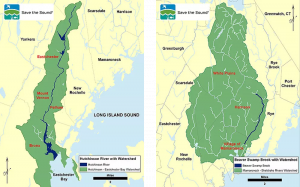2017 Bacteria Monitoring Stats
63 sites, 639 water samples,
30 trained volunteers
2017 Bacteria Sampling Data
Westchester, NY & Greenwich, CT pdf
Queens & Nassau Counties pdf
Summary by Site pdf
Quality Assurance Project Plan pdf
Quick Links
Best and Worst
Summary of Findings
Rivers Polluted
Action Items
Map Legend

In 2017, Save the Sound collected and tested water quality from Greenwich, CT, through Westchester County, to Queens and into Nassau County. Samples were analyzed for the fecal indicator bacteria Enterococcus, which can affect human health. Explore the map above to see what we found. The colors reflect average bacteria levels which give a sense of how high the fecal contamination levels can get at each site. The “% Pass” and “% Fail” show how many samples passed or failed the single sample criteria for safe swimming in New York and Connecticut.
Summary of Findings
Overall reduction in fecal bacteria
We are seeing incremental reductions in pollution. Fecal contamination rates overall dropped from 49% contaminated in 2016 to 43% contaminated in 2017.
Failure is based on EPA safe swimming criteria used in CT and NY to monitor and manage beaches
Sound Beaches looking good
We added more swimming beach sites to our study in 2017. With an overall failure rate of 7%, these local beaches are comparable with beach quality nationwide.[1]
Failure is based on EPA safe swimming criteria used in CT and NY to monitor and manage beaches
Beaches we monitored:
Byram Park, Greenwich, CT
Douglaston Manor Beach, Queens, NYC, NY
Harbor Island Beach, Mamaroneck, NY
Shore Acres Yacht Club, Mamaroneck Village, NY
Rye Playland Park, Rye, NY
Beach Point Club, Mamaroneck Village, NY
Glen Island Park, New Rochelle, NY
To see trends on water quality at every beach on Long Island Sound, visit our site Sound Health Explorer.
[1] According to NRDC’s series of reports, “Testing the Waters,” the average beach failure rate for fecal bacteria is 8%.Rivers in the study are still polluted
Area streams, creeks, and rivers are still polluted and continue to carry that pollution to Long Island Sound. The fecal bacteria levels in these tributaries declined slightly this year, from a 66% failure rate in 2016 to a 63% failure rate in 2017. Clearly, there is lots of room for improvement!
Failure is based on EPA safe swimming criteria used in CT and NY to monitor and manage beaches
2017 Season Best and Worst
Ten Sites with the Lowest Fecal Contamination Levels (No Failing Samples)
Scores >104 are considered unsafe for swimming in marine water and > 61 are considered unsafe for freshwater.
Average (GeoMean) > 35 are considered unsafe for swimming in marine water and > 33 are considered unsafe in freshwater.
Ten Sites with the Highest Fecal Contamination Levels
Scores >104 are considered unsafe for swimming in marine water and > 61 are considered unsafe for freshwater. Average (GeoMean) > 35 are considered unsafe for swimming in marine water and > 33 are considered unsafe in freshwater.
Be a Part of the Solution
- Everyone can help reduce sewage pollution sources simply by conserving water, which will lessen the wear-and-tear on our water infrastructure and reduce sewage overflows by lowering the volume of water in the system.
- Homeowners need to repair the sewer lines that connect homes and businesses to municipal sewers, or maintain their septic systems.
- Dog owners should put pet waste in the trash, never in a catch basin or on the street.
- If you see sewage overflowing in your community, please let us know by sending a photograph or video and the time and location of the overflow to pollution@savethesound.org.

